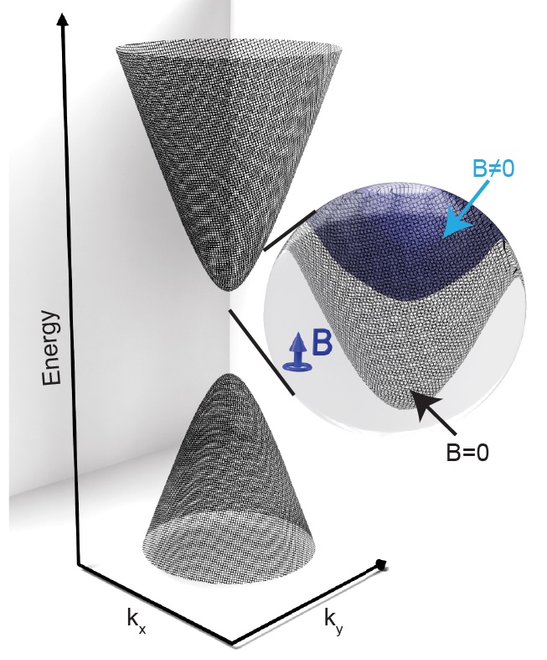Working with a quantum material called a kagome magnet, a group of Boston College physicists and collaborators have directly observed how individual electronic quantum states in the unique material respond to external magnetic fields by unexpectedly changing the energy. The researcher’s findings were published in the most recent online issue of the journal Nature Physics.
 Schematic of the Dirac band evolution in a magnetic field. Blue (grey mesh) cones depict the massive Dirac fermion at non-zero (zero) external magnetic field. Image Credit: Nature Physics.
Schematic of the Dirac band evolution in a magnetic field. Blue (grey mesh) cones depict the massive Dirac fermion at non-zero (zero) external magnetic field. Image Credit: Nature Physics.
According to the researchers, who cooperated with experts at Renmin University in Beijing, China, the measurements made by the study are the first of their kind to directly detect the momentum-resolved, field-induced development of these quantum states.
According to Boston College Associate Professor of Physics Ilija Zeljkovic, a lead co-author of the study, the results present the first experimental demonstration of theoretical analysis about how electronic band structure can shift in these innovative materials, in this case—bulk single crystals of yttrium manganese tin YMn6Sn6.
When a magnetic field is applied to a material, electronic band structure—which is a collection of quantum states that electrons in solids can occupy—can change in unusual ways. These changes have thus far been inferred from theoretical calculations or accessed indirectly from field-induced changes in macroscopic measurable properties. Direct measurement of field-induced changes to the electronic band structure has been difficult to measure.
Ilija Zeljkovic, Study Lead Co-Author and Associate Professor, Physics, Boston College
The group overcomes the experimental difficulties of spectroscopic-imaging scanning tunneling microscopy to analyze the material. Kagome magnets, such as the YMn6Sn6 investigated by the researchers, are named after the magnetic structure and atomic lattice of Japanese “kagome” weaved baskets.
Dirac fermions, which Zeljkovic defined as quasiparticles with zero mass and a linear energy-momentum dispersion in an electronic band structure matching relativistic particles, are found in Kagome magnets.
Theoretical physicists such as Zeljkovic’s collaborator and co-author, Boston College Professor of Physics Ziqiang Wang, have analytically demonstrated that Dirac fermions may develop in response to a magnetic field in terms of energy and momentum. According to Zeljkovic, the team set out to put those forecasts to the test.
According to the Nature Physics report, “Manipulation of Dirac band curvature and momentum-dependent g-factor in a kagome magnet,” the group found that quantum states linked with Dirac fermions respond strongly to the magnetic field, switching to higher energies irrespective of the direction of the field.
Interestingly, they exhibit a momentum-dependent shift—for a set magnetic field, quantum states near the Dirac point shift the most; the shift becomes progressively smaller away from the Dirac point.
Ilija Zeljkovic, Study Lead Co-Author and Associate Professor, Physics, Boston College
The Dirac point is the intersection of the conduction and valence bands in energy-momentum space.
Based on the direction of spins lying largely in-plane, Zeljkovic predicted that the system without a magnetic field could host massless—or zero mass—Dirac fermions. Instead, the researchers discovered that Dirac fermions in this material had finite mass at zero fields. Theoreticians will have to undertake further studies to find out why this happened.
According to Zeljkovic, there are many more problems to be answered based on the results from an experimental approach. Multiple conflicting processes that involve electron spin and orbital degrees of freedom, for example, might lead to a momentum-dependent band development.
One of the most fascinating possibilities, according to Zeljkovic, is orbital magnetism, a feature that has suddenly sparked interest and enthusiasm among researchers exploring “twisted” van der Waals structures.
Our future experiments will focus on disentangling different contributions and examining orbital magnetism in this and related kagome magnets.
Ilija Zeljkovic, Study Lead Co-Author and Associate Professor, Physics, Boston College
Wang’s study was sponsored by a grant from the US Department of Energy’s Office of Basic Energy Sciences and a Cottrell SEED Award from the Research Corporation for Science Advancement. Zeljkovic’s research was supported by funding from the Army Research Office.
Journal Reference:
Li, H., et al. (2022) Manipulation of Dirac band curvature and momentum-dependent g factor in a kagome magnet. Nature Physics. doi.org/10.1038/s41567-022-01558-3.